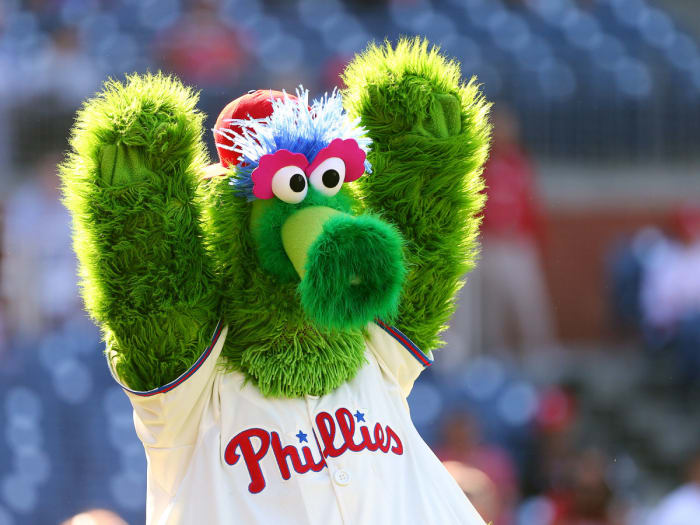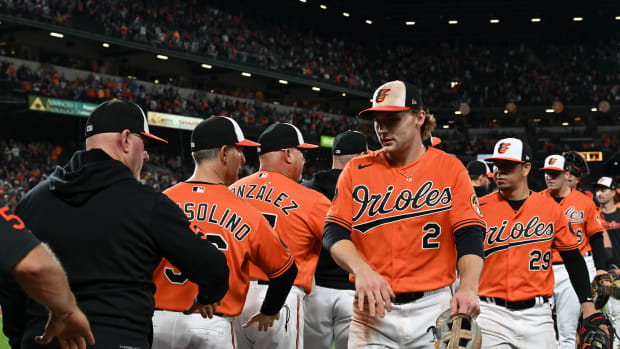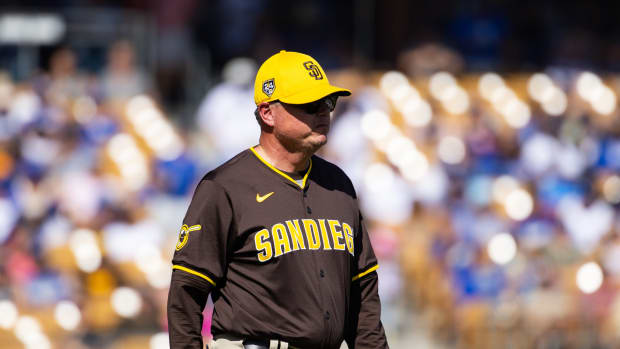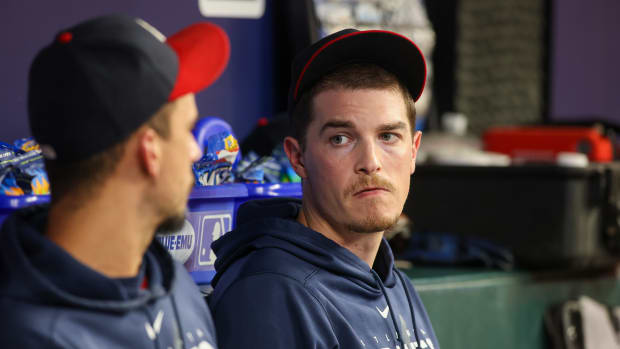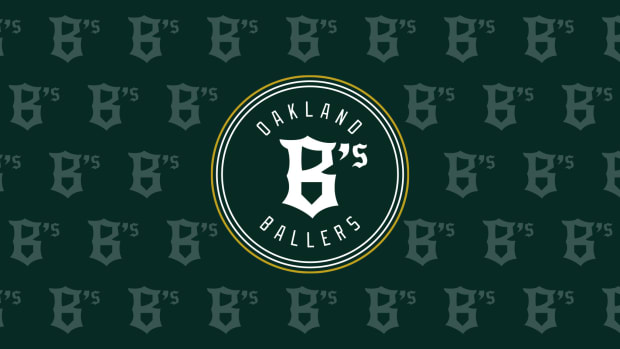Will Phillies Have to Ditch Phillie Phanatic Mascot?
For the past 41 years, Philadelphia Phillies fans have been entertained by the Phillie Phanatic, the team’s green and furry mascot. A new federal lawsuit leaves the Phanatic’s future with the team in doubt.
On August 2, the Phillies filed a copyright lawsuit in the U.S. District for the Southern District of New York. The club is suing a group of defendants who assert that they are the rightful creators of the Phanatic and who, according to the Phillies, demand “millions of dollars” from the club. As the Phillies tell it, they’ve been threatened that if they don’t pay up, the Phanatic will be declared a “free agent”—meaning, at least in theory, another club could negotiate to use the costume.
The defendants are Bonnie Erickson, her husband Wayde Harrison and their company Harrison/Erickson. Erickson, 78, is a well-known designer of costumes and puppets. Back in the 1970s, she created Miss Piggy and other famous puppets who appeared on The Muppet Show, Fraggle Rock and other shows associated with famed puppeteer Jim Henson. Erickson is also credited with creating Youppi!, the Montreal Canadians’ mascot and previously the mascot of the Montreal Expos. Harrison is a fellow puppet creator.
Among other things, the Phillies seek a court order that would categorically authorize the club’s continued use of the Phanatic—both as a mascot and as a source of numerous Phanatic-inspired products. Judge Victor Marrero is presiding over the case. The Phillies have retained the law firm Duane Morris and four of its attorneys (David McTaggart, David Wolfsohn, Tyler Marandola and Kendra Oxholm) to represent them.
The debate over the Phanatic’s origin
The person or persons responsible for creating the Phanatic is a matter of dispute.
Prior to the 1978 season, the Phillies used two colonial figures, Phil and Phyllis, as their mascot. As the Phillies retell history, club vice president Bill Giles made the executive decision in February 1978 that the Phillies needed a new mascot. Giles regarded Phil and Phyllis as not allowing “for much movement or expression of personality.” Essentially, the team’s colonial-inspired mascots were viewed as somewhat dull.
Giles then had a “vision” for an “in your face” kind of mascot. He imagined one who would be “green, fat, furry, big-nosed, and instantly accessible to children.” This mascot would eventually be called the Phanatic—a name that comported with the club’s use of “phanatic” in other promotions. The Phanatic would embody “the quintessential fanatical Phillies fan.” To that end, the Phanatic would be expected to “engage in audacious slapstick routines, playfully teasing anyone within range of the field or the stands—players, umpires, sportscasters, managers, and fans.”
Since Giles, who later became a co-owner of the Phillies, was not a costume designer, he and fellow Phillies executives sought to retain professionals who could take his specifications and convert them into a physical costume. In March 1978, the club hired Harrison/Erickson. About two weeks later, the Phanatic costume, which used materials provided by the Phillies, was ready.
Harrison/Erickson was paid approximately a combined $5,900 for its services, labor and costs. As a point of reference, $5,900 in 1978 would now-a-days be worth about $23,200. The agreement contemplated that the Phillies gained the right to use the costume on television, in commercials and in personal appearances.
The Phillies then directed one of its marketing interns, Dave Raymond, to don the costume. Raymond would be the person behind the Phanatic on April 25, 1978, the first time it appeared in a game. The Phanatic was an instant hit with fans and much more fun than Phil and Phyllis. Raymond, whom the Phillies would send to mime school in order to enhance his skills, would personify the Phanatic for the next 16 seasons.
The Phillies’ narrative thus credits Giles as the person mainly responsible for the Phanatic. Erickson and Harrison, meanwhile, are depicted as translating someone else’s idea into a physical construction.
Although Erickson and Harrison have not yet answered the Phillies’ complaint, expect them to offer a vastly different account of their role. Some clues can be found in Erickson’s recent public statements. She was interviewed last month by Noam Osband of WBUR, a public radio station in Boston, for WBUR’s Only A Game show. Erickson recalled how the Phillies approached Henson to see if he would be willing to design a team mascot. He declined but encouraged the team to hire Erickson, who had worked for Henson.
Erickson clearly views herself as playing a much more instrumental role in the concept of the Phanatic than the Phillies represent in their lawsuit. Specifically, Erickson told Osband:
"I think I wanted to make a shape that was going to have its own sort of character. So that if you put a performer or a human being in it, it was going to be funny just because of the way it moved . . . I took [the Phillies Phanatic slogan] as wanting to have a megaphone. So that’s where the snout for the Phanatic came from . . . And on the back, we wanted to give him a sort of logo of his own, so we gave him a five-pointed star.”
Erickson further explained that, like with the puppets she created for Henson, she produced a biography and accompanying personality for the Phanatic. The Phanatic, according to Erickson, “evolved in the Galapagos and became this enormous baseball fan. Because, we figured, who could contest that? This seemed to be the perfect background for a character that nobody could describe. It's a purely fantasy animal."
Money, control and the Phanatic
Per licensing agreements with the Phillies, Harrison/Erickson would earn more than $200,000 in royalties by 1980. These agreements covered the Phillies developing “Phanatic-themed promotional items,” including key chains, pennants and t-shirts.
Despite earning considerable monies from the Phanatic, Harrison and Erickson were displeased with what they perceived as a lack of control over the Phillies’ enlarging use of the mascot’s likeness for merchandise. On behalf of their company, the couple sued the Phillies in 1979 for copyright infringement.
The 1979 litigation revealed that Harrison/Erickson had obtained from the U.S. Copyright Office a registration for the Phanatic. However, as the Phillies stress, the copyright was not for a costume. The Phanatic was instead registered as an “artistic sculpture” and described as a “shaggy creature wearing tennis shoes, tights and baseball shirt while carrying pennant.” As explained below, the Phillies contend that by registering the Phanatic as an “artistic sculpture”, Harrison and Erickson were attempting to dupe the Copyright Office.
The Phillies and Harrison/Erickson settled the lawsuit out of court. For the next few years, they continued an arrangement whereby the team would pay Harrison/Erickson for the exclusive right to use the Phanatic.
In 1984, Harrison/Erickson assigned all of the company’s rights in the Phanatic to the Phillies for $215,000. Such an assignment was “forever.” Sports Illustrated has obtained a copy of the contract, which is dated Oct. 31, 1984. In it, Harrison/Erickson “sells, transfers and assigns to the Phillies all of its rights, title and interest in and to the mascot and in and to all reproductions and portrayals of all or part of the mascot in any medium whatsoever, everywhere and forever.”
Over the next few decades, the Phillies would invest considerably in the Phanatic and make it integral to the club’s identity. The Phillies have registered various trademarks for numerous products associated with the Phanatic. Those products include: headwear, shirts, cloth bibs, infant ware, footwear, socks, hosiery, stuffed toys, plush toys, soft sculpture foam toys, foam novelty items, namely foam fingers, puppets, toy figures, dolls, bobbing head dolls, playground balls, baseball bats, inflatable toys, Christmas tree ornaments and decorations, action figures, trading cards, posters, stickers, decals, temporary tattoos, bumper stickers, books featuring baseball, memo boards, mounted and un-mounted photographs, pens, pencils, art pictures, and art prints.
Further, the Phillies employ the Phanatic for a wide-range of activities. In addition to baseball games, the Phanatic appears at charitable events, schools, clinics and exhibitions.
It should be noted the Phanatic’s playful and active style has sometimes caused problems. According to University of Arkansas School of Law professor (and former Chief Justice of the Arkansas Supreme Court) Howard Brill and his co-author, Christian Brill, the Phanatic “is the most-sued mascot in baseball.” Their 2016 Kansas Law Review article, Baseball Mascots and the Law, is a terrific read on the many lawsuits brought on account of mascot-caused injuries.
The Brills detail several incidents involving the Phanatic that led to litigation. One occurred during a game in 1993. The Phanatic was accused of kicking a pregnant fan in the back and shoving her head forward. She suffered back and neck injuries in this incident. This fan sued the Phillies demanding $1 million. She won a jury trial but was awarded only $25,000.
Harrison/Erickson initiate a potential legal action
The Phillies are suing in response to a letter that club chairman, David Montgomery, received last year from attorneys on behalf of Harrison/Erickson. The letter was dated June 1, 2018. In it, Harrison/Erickson insist that the company is the legal author of the Phanatic and can terminate the Phillies’ rights to use the Phanatic as early as June 15, 2020.
The letter also asserts that the Phillies can’t rely on the “derivative works exception” under copyright law to claim protection over the various Phanatic-inspired products. A derivative work is one that is based at least in part on a pre-existing work (in this case the Phanatic) but that also possesses sufficient elements of originality to distinguish it from the pre-existing work.
According to the Phillies, Harrison/Erickson have demanded “exorbitant sums” from the club. If the money isn’t paid, Harrison/Erickson could sue the Phillies for copyright infringement, both with respect to the Phanatic and with respect to numerous Phanatic-inspired products marketed by the Phillies. Harrison/Erickson could also attempt to sell its rights in the Phanatic to another team, be it one in baseball or a different sport.
The delay between the June 2018 letter and the August 2019 commencement of the litigation reflects attempts by attorneys for both sides to negotiate a settlement. Those attempts clearly failed.
The club now seeks a jury trial and six declaratory judgments from Judge Marrero. Each declaratory judgment would solidify the team’s ability to use the Phanatic as a mascot and as a source for retail products. The team also claims that Harrison/Erickson has breached the 1984 contract. In addition, the Phillies assert that Harrison/Erickson would be unjustly enriched if it is able to recapture ownership of the Phanatic when it already agreed to assign away its rights.
Of the six declaratory judgments sought by the Phillies, a key one is that Harrison/Erickson has no legal right to terminate its “everywhere and forever” assignment of “all” rights from 1984. To buttress that argument, the Phillies highlight that the federal Copyright Act “does not provide authors with multiple opportunities to renegotiate grants of copyrights after they have full knowledge of the market value of the works at issue; an author has only a single opportunity to revisit the terms of its grant.”
A second declaratory judgment sought by the Phillies is that Harrison/Erickson has no right to enforce its claimed copyrights “because of its fraud on the Copyright Office.” This alleged fraud refers to Harrison/Erickson representing to the Copyright Office that the Phanatic was an “artistic sculpture” when in reality it was a costume. The supposedly fraudulent act is that Harrison/Erickson may have been aware that if it described the Phanatic as a costume, the Copyright Office—which at the time often rejected costumes applications on the theory that costumes are merely people wearing apparel—would have rejected the application. In fact, the Phillies argue that Harrison/Erickson went so far as to disguise the true nature of the Phanatic by submitting a “poor-quality photo that obscured the fact that the work was a costume”:
A more accurate photo of a costume without a person , the Phillies assert, would be one along these lines:
As a third desired declaratory judgment, the Phillies demand that Judge Marrero order Harrison/Erickson to not terminate the Phillies’ rights “as the author of the Phanatic’s character.” The club maintains that Raymond—the marketing intern who became the person behind the mascot—is the person who “developed a fun and sensitive character.” The Club also insists that it contributed substantial content with respect to the Phanatic’s “backstories, personality traits and other distinctive features.” As mentioned above, Erickson suggested to WBUR that she is the person who came up with the Fanatic’s traits and backstory.
The Phillies further demand that Judge Marrero declare the club was within its rights to create numerous derivate works in the form of “costumes, routines, designs, artwork, logos, promotional products, and retail products.” The club contends that pursuant to the derivative works exception recognized by copyright law, even if Harrison/Erickson could terminate certain rights found in the 1984 agreement, it can’t “terminate the Phillies’ rights to use the derivative works developed before June 15, 2020.”
Chances are, the Phanatic will remain in Citizens Bank Park
In the coming weeks, attorneys for Harrison and Erickson will answer the Phillies’ complaint. The answer will deny most of the club’s accusations and—as alluded to in Erickson’s interview with WBUR—portray Erickson, in particular, as the person most responsible for what makes the Phanatic so unique and popular.
The litigation could play out over months, if not longer, though it probably won’t end in a trial. It’s clear the two sides have been engaged in settlement talks over the past year. Since this case would be resolvable if both sides can agree on a dollar figure, both sides know the path to a resolution. They also settled a lawsuit once before.
If a settlement does not surface in the near future and if the case is not dismissed, both sides would become subject to pretrial discovery. As a result, Phillies executives would be called to testify and share emails and other correspondences about the Phanatic and, perhaps more importantly, the team’s considerable investment in Phanatic-inspired products and services. Given the passage of time and the lack of electronic records in the 70s and 80s, some of the key facts might depend on the reliability of human memories. At the same time, Harrison and Erickson would need to explain why their 1984 agreement did not extinguish their rights in the Phanatic.
Michael McCann is SI’s Legal Analyst. He is also an attorney and Director of the Sports and Entertainment Law Institute at the University of New Hampshire Franklin Pierce School of Law.































